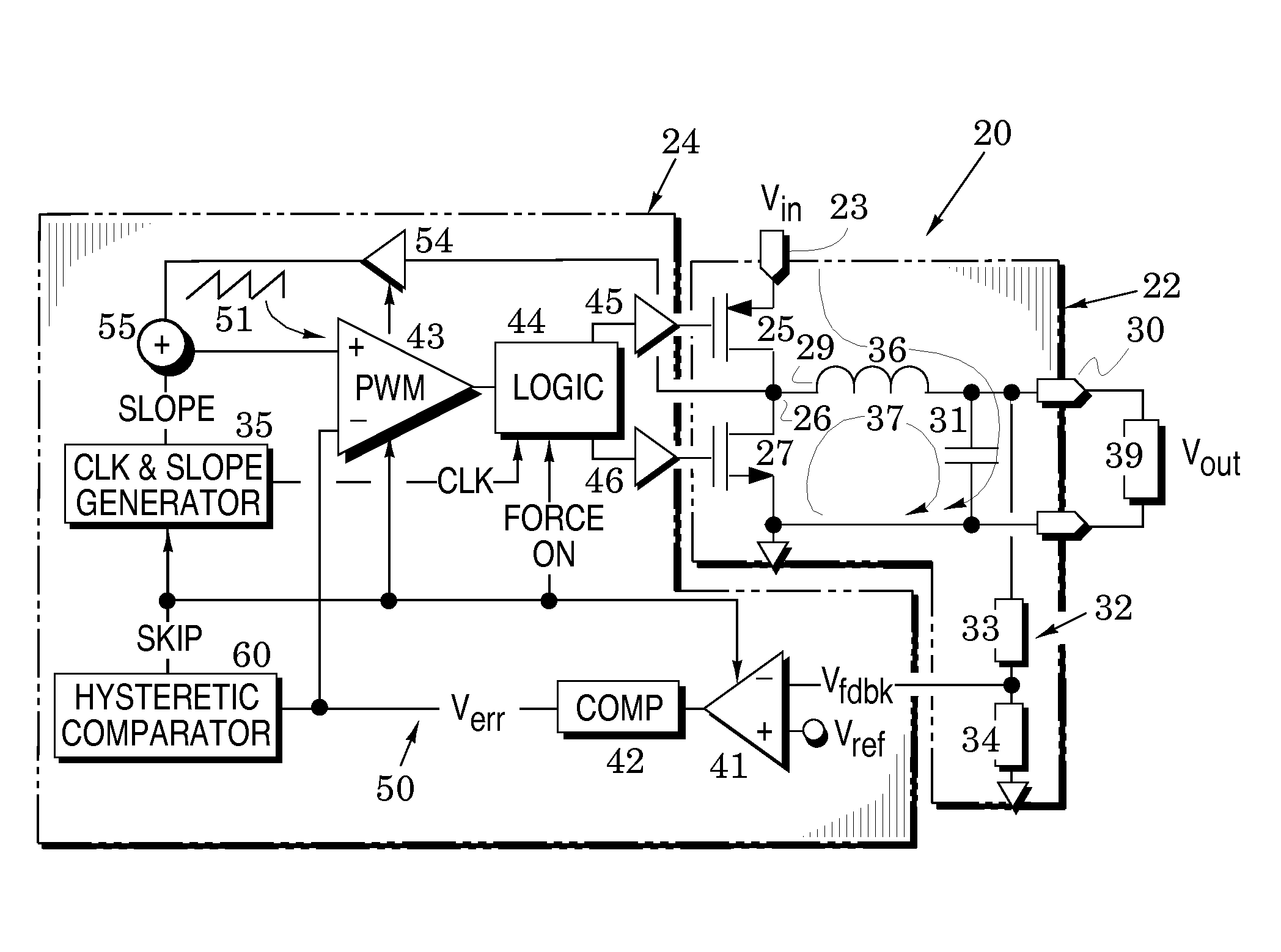Switching voltage regulators with hysteretic control for enhanced mode-transition speed and stability
a voltage regulator and hysteretic control technology, applied in the direction of power conversion systems, dc-dc conversion, instant pulse delivery arrangements, etc., can solve the problem of slow transition between these operational modes, and achieve the effect of improving the speed and stability of the mode transition
- Summary
- Abstract
- Description
- Claims
- Application Information
AI Technical Summary
Problems solved by technology
Method used
Image
Examples
embodiment 20
[0015]In particular, FIG. 1 illustrates a switching voltage regulator embodiment 20 that comprises an output stage 22 and a feedback controller 24. The output stage includes a first transistor 25 coupled between an input port 23 and a swinging node 26, a second transistor 27 coupled between the swinging node and circuit ground, and an inductor 29 coupled between the swinging node 26 and an output port 30. A capacitor 31 is coupled across the output port and a voltage divider 32 is coupled to the top of the output port. The voltage divider is formed by first and second impedances such as first and second resistors 33 and 34. In a regulator embodiment, the transistors may be metal-oxide-semiconductor, field effect (MOSFET) transistors and, if so, the drains of the transistors are preferably coupled to the swinging node 26.
[0016]The output stage 22 operates at a clock rate determined by a clock signal (CLK) from a clock and slope generator 35. In operation of the output stage 22, the f...
embodiment 80
[0028]The graph 70 of FIG. 2 illustrates various waveforms in the voltage regulator 20 as it transitions between its PWM and PFM operational modes. Before describing the operations of this graph, however, it will be instructive to first describe operation of the hysteretic comparator 60. Accordingly, attention is now directed to FIG. 3A which illustrates a hysteretic comparator embodiment 80. As shown, it includes a comparator 81 which drives an inverter 82 to generate the skip signal of FIG. 1. A first switch 84 is arranged to couple a high threshold voltage Vhth to the negative input of the comparator 81 and this first switch is closed when the output of the inverter 82 is high. A second switch 85 is arranged to couple a low threshold voltage Vhth to the negative input of the comparator and this second switch is closed when the output of the comparator 81 is high. Finally, a capacitor 86 is coupled from the output of the inverter 82 back to a summer 87 positioned between the switc...
embodiment 90
[0035]FIG. 3C illustrates another embodiment 90 of the hysteretic comparator. In this embodiment, a differential amplifier 92 is formed by a differential pair 93 of transistors 94 and 95 that are positioned to receive a tail current from a current transistor 96 (biased by a tail voltage Vt) and drive load transistors 97 and 98 that are biased by a first bias voltage Vb1. The transistor 95 receives a low threshold voltage Vlth at its gate. A diode-coupled transistor 100 is drain-coupled to a current transistor 101 whose source is coupled to one side of the differential pair 93 and whose gate is coupled to a second bias voltage Vb2. Another transistor 102 is gate-coupled to the transistor 100 and drain-coupled to a current transistor 103 whose source is coupled to the other side of the differential pair 93 and whose base is coupled to the second bias voltage Vb2.
[0036]A current transistor 106 has its gate coupled to receive the first bias voltage Vb1 and is drain-coupled to a transist...
PUM
 Login to View More
Login to View More Abstract
Description
Claims
Application Information
 Login to View More
Login to View More - R&D
- Intellectual Property
- Life Sciences
- Materials
- Tech Scout
- Unparalleled Data Quality
- Higher Quality Content
- 60% Fewer Hallucinations
Browse by: Latest US Patents, China's latest patents, Technical Efficacy Thesaurus, Application Domain, Technology Topic, Popular Technical Reports.
© 2025 PatSnap. All rights reserved.Legal|Privacy policy|Modern Slavery Act Transparency Statement|Sitemap|About US| Contact US: help@patsnap.com



